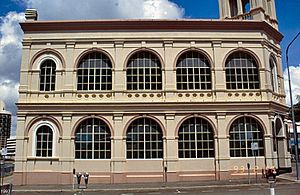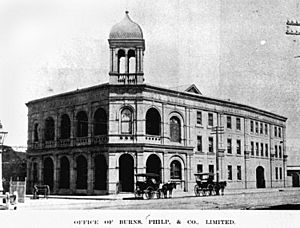Burns Philp Building, Townsville facts for kids
Quick facts for kids Burns Philp Building, Townsville |
|
|---|---|

The former Burns Philip & Company Ltd Building, 1993
|
|
| Location | 108-124 Flinders Street, Townsville CBD, City of Townsville, Queensland, Australia |
| Design period | 1870s - 1890s (late 19th century) |
| Built | 1895 |
| Architect | McCredie Brothers |
| Official name: Burns, Philp & Company Ltd Building (former) | |
| Type | state heritage (built) |
| Designated | 27 August 1993 |
| Reference no. | 600914 |
| Significant period | 1890s, 1920s (fabric) 1895-1977 (historical use by Burns Philps) |
| Significant components | pavilion, tower - observation/lookout, loggia/s |
| Builders | G S Gordon |
| Lua error in Module:Location_map at line 420: attempt to index field 'wikibase' (a nil value). | |
The Burns Philp Building is a special old office building in Townsville CBD, Queensland, Australia. It's listed on the Queensland Heritage Register, which means it's an important historical place. The building was designed by McCredie Brothers and built in 1895 by G S Gordon.
Contents
A Look Back: The Building's Story
This big stone building was finished in 1895. It was built for Burns, Philp & Company Ltd, a very successful trading company in North Queensland. This company helped North Queensland grow a lot.
How Burns Philp Started
The company began in Townsville in 1872. A man named James Burns opened a general store. Later, in 1876, Robert Philp joined him. Robert Philp later became the Premier of Queensland twice!
James Burns went back to Sydney in 1877 because he was sick. Robert Philp stayed in Townsville to manage the store.
Growing the Business
In the late 1870s and early 1880s, Burns and Philp each built their own trading networks. They combined them in 1883 to form Burns, Philp & Company Ltd. By 1887, they stopped selling directly to people. Instead, they focused on bringing in goods from other places and selling them to other businesses. They also handled shipping and insurance.
The company had offices in many places, including London, Sydney, Brisbane, and even New Guinea. They had 300 employees and their own ships. They were pioneers in trade and communication across North Queensland and the South Pacific. They also invested in sugar farms and gold mines. Even though Robert Philp left the company in 1893, the name Burns, Philp & Company Ltd stayed.
Building a Landmark
In Townsville, Burns, Philp & Company Ltd owned a lot of land along Ross Creek. They built wharves and warehouses there. Their main offices were in an old building from the 1860s. By 1895, Burns, Philp & Company Ltd was very important to Townsville. So, they decided to build a large new office building.
The company's architects from Sydney, McCredie Bros, designed the new building. It took only nine months to build by contractor GS Gordon. The building officially opened on 12 November 1895.
The building had two main parts. The two-storey section faced Wickham and Flinders Streets. This part held the main offices. The shipping department was on the ground floor. The manager's office and other departments were upstairs. The three-storey section along Flinders Street was mostly for storage (warehousing).
Changes Over Time
The building was designed so it could be made bigger later. Its walls had special arches that could be opened for new sections. In 1913-14, a long, single-storey warehouse was added, but it has since been taken down.
In 1922, the company's architect in Townsville, Walter Hunt, made changes to the offices and warehouse. The office area was made larger. Some large arched doorways were closed off and replaced with windows.
Later, a fire damaged the inside of the warehouse. The roof and floors had to be replaced.
Burns, Philp & Company Ltd used the building until 1977. After that, the two-storey section became a nightclub. The warehouse part was changed into office spaces.
What the Building Looks Like
The former Burns, Philp and Company Ltd building is on the corner of Flinders and Wickham Streets, with Ross Creek behind it. It's made of stone with a smooth finish. It has a two-storey part at the corner and a three-storey part along Flinders Street.
Corner Section Details
The two-storey corner section has five arched openings along Wickham Street and two along Flinders Street. Each opening is separated by a flat, column-like shape called a pilaster. There's a deep decorative band, called a cornice, between the floors and at the roofline. The roof is hidden and made of corrugated iron.
Originally, the arched openings were open, like an arcade. Now, they have metal-framed glass. The corner entrance on the ground floor is still open. The corner of the building has a special top part called a pavilion. It has two arches, a decorative railing (balustrade), and a rebuilt curved roof. The nightclub entrance has a tiled floor and steel gates.
Flinders Street Section Details
The front of the three-storey Flinders Street section has four main parts. These are separated by pairs of pilasters. A deep cornice hides the curved corrugated iron roof. Most parts have two aluminum-framed windows on each floor. One part has four windows per floor. The ground floor of this section has a single entrance and two windows, with a roof-like structure (awning) sticking out.
Inside the Building
The corner section is now a nightclub on both floors. The ground floor connects to the next section through openings with columns. These columns have plaques that say "1895". Most of the inside parts, like the staircase and ceilings, are new.
The Flinders Street section has a central entrance and staircase. Office spaces are on either side. Only the outer walls of this part are original.
A plant room, built in 1978, is at the back of the building. It holds equipment like air conditioning units.
Why This Building is Important
The former Burns Philp & Company building was added to the Queensland Heritage Register on 27 August 1993. This means it's recognized as a very important part of Queensland's history and culture.
Showing Queensland's History
This building helps us understand how Queensland's history unfolded. It shows how important Burns, Philp & Company Ltd was to Townsville's growth as a main port in North Queensland in the late 1800s.
A Unique Part of History
It's special because it's the only 19th-century warehouse and office building left along Ross Creek. It's a reminder of Burns, Philp & Company Ltd's huge complex in Townsville. In the 1890s, their property included offices, wharves, warehouses, and workshops.
A Great Example of Design
The building shows what a large business building looked like back then. Its design combines offices and a warehouse in a grand, classic style. It also shows the work of the Sydney architects McCredie Bros.
Beautiful and Valued
The building is important for its beauty. It looks great at the intersection of Flinders and Wickham Streets. People in Townsville value its design and some of its original interior parts.
Important to the Community
It's a well-known landmark in Townsville. It makes the community proud of Townsville's history as a major port in North Queensland.
Connected to Important People
The building has a special connection to the successful Burns, Philp & Company. The company started in Townsville and played a big part in developing North Queensland in the late 1800s and early 1900s.


